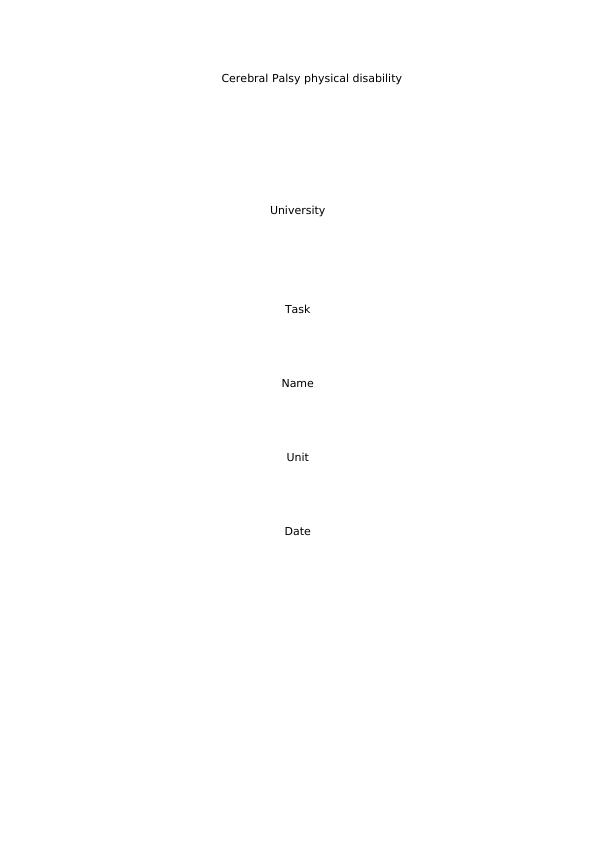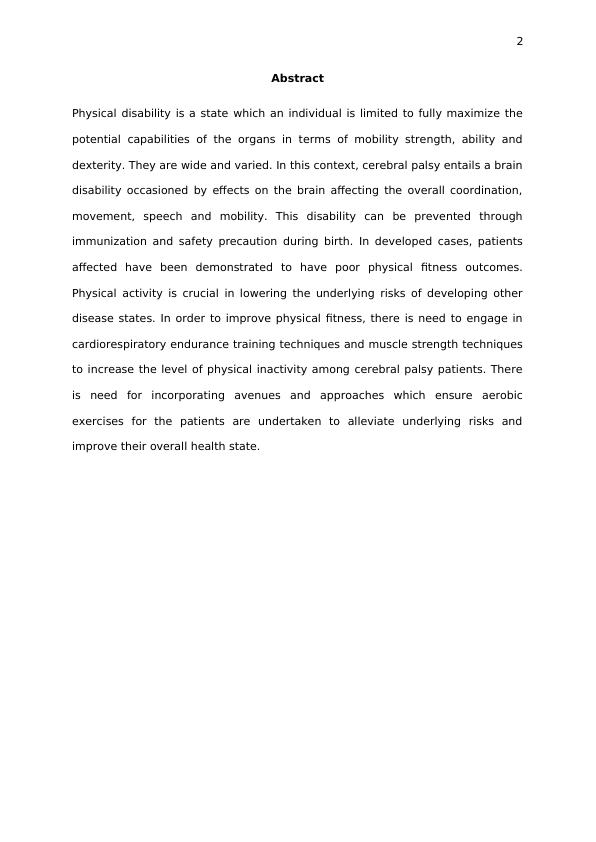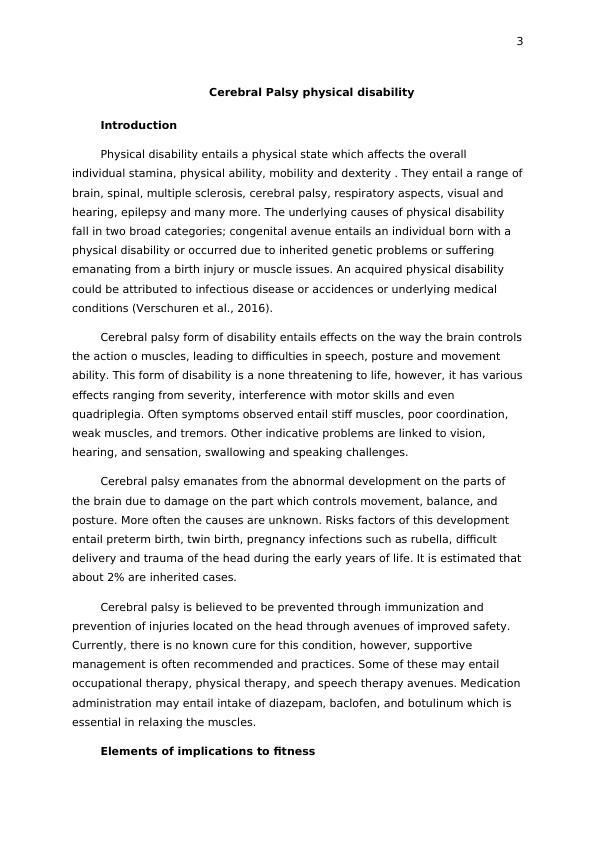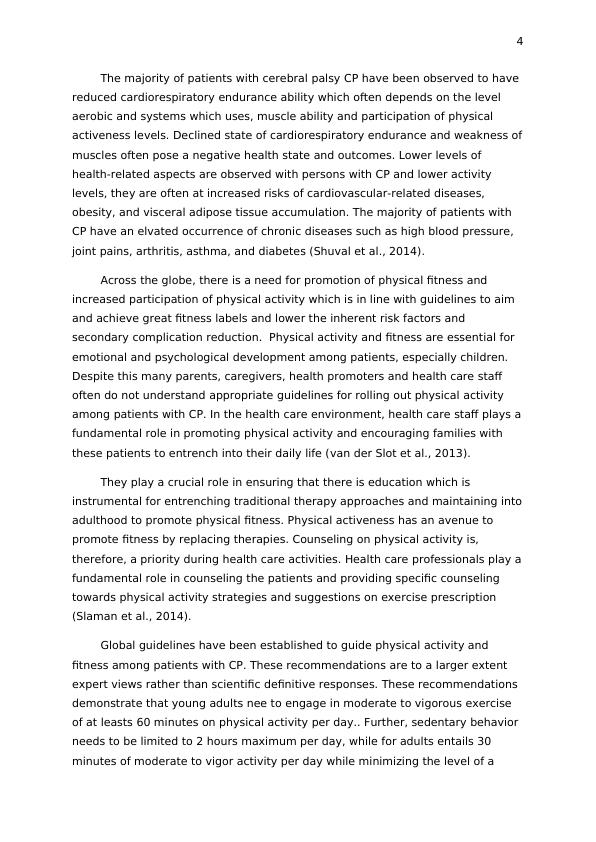Cerebral Palsy physical disability
Added on 2022-08-28
11 Pages3258 Words18 Views
Cerebral Palsy physical disability
University
Task
Name
Unit
Date
University
Task
Name
Unit
Date

2
Abstract
Physical disability is a state which an individual is limited to fully maximize the
potential capabilities of the organs in terms of mobility strength, ability and
dexterity. They are wide and varied. In this context, cerebral palsy entails a brain
disability occasioned by effects on the brain affecting the overall coordination,
movement, speech and mobility. This disability can be prevented through
immunization and safety precaution during birth. In developed cases, patients
affected have been demonstrated to have poor physical fitness outcomes.
Physical activity is crucial in lowering the underlying risks of developing other
disease states. In order to improve physical fitness, there is need to engage in
cardiorespiratory endurance training techniques and muscle strength techniques
to increase the level of physical inactivity among cerebral palsy patients. There
is need for incorporating avenues and approaches which ensure aerobic
exercises for the patients are undertaken to alleviate underlying risks and
improve their overall health state.
Abstract
Physical disability is a state which an individual is limited to fully maximize the
potential capabilities of the organs in terms of mobility strength, ability and
dexterity. They are wide and varied. In this context, cerebral palsy entails a brain
disability occasioned by effects on the brain affecting the overall coordination,
movement, speech and mobility. This disability can be prevented through
immunization and safety precaution during birth. In developed cases, patients
affected have been demonstrated to have poor physical fitness outcomes.
Physical activity is crucial in lowering the underlying risks of developing other
disease states. In order to improve physical fitness, there is need to engage in
cardiorespiratory endurance training techniques and muscle strength techniques
to increase the level of physical inactivity among cerebral palsy patients. There
is need for incorporating avenues and approaches which ensure aerobic
exercises for the patients are undertaken to alleviate underlying risks and
improve their overall health state.

3
Cerebral Palsy physical disability
Introduction
Physical disability entails a physical state which affects the overall
individual stamina, physical ability, mobility and dexterity . They entail a range of
brain, spinal, multiple sclerosis, cerebral palsy, respiratory aspects, visual and
hearing, epilepsy and many more. The underlying causes of physical disability
fall in two broad categories; congenital avenue entails an individual born with a
physical disability or occurred due to inherited genetic problems or suffering
emanating from a birth injury or muscle issues. An acquired physical disability
could be attributed to infectious disease or accidences or underlying medical
conditions (Verschuren et al., 2016).
Cerebral palsy form of disability entails effects on the way the brain controls
the action o muscles, leading to difficulties in speech, posture and movement
ability. This form of disability is a none threatening to life, however, it has various
effects ranging from severity, interference with motor skills and even
quadriplegia. Often symptoms observed entail stiff muscles, poor coordination,
weak muscles, and tremors. Other indicative problems are linked to vision,
hearing, and sensation, swallowing and speaking challenges.
Cerebral palsy emanates from the abnormal development on the parts of
the brain due to damage on the part which controls movement, balance, and
posture. More often the causes are unknown. Risks factors of this development
entail preterm birth, twin birth, pregnancy infections such as rubella, difficult
delivery and trauma of the head during the early years of life. It is estimated that
about 2% are inherited cases.
Cerebral palsy is believed to be prevented through immunization and
prevention of injuries located on the head through avenues of improved safety.
Currently, there is no known cure for this condition, however, supportive
management is often recommended and practices. Some of these may entail
occupational therapy, physical therapy, and speech therapy avenues. Medication
administration may entail intake of diazepam, baclofen, and botulinum which is
essential in relaxing the muscles.
Elements of implications to fitness
Cerebral Palsy physical disability
Introduction
Physical disability entails a physical state which affects the overall
individual stamina, physical ability, mobility and dexterity . They entail a range of
brain, spinal, multiple sclerosis, cerebral palsy, respiratory aspects, visual and
hearing, epilepsy and many more. The underlying causes of physical disability
fall in two broad categories; congenital avenue entails an individual born with a
physical disability or occurred due to inherited genetic problems or suffering
emanating from a birth injury or muscle issues. An acquired physical disability
could be attributed to infectious disease or accidences or underlying medical
conditions (Verschuren et al., 2016).
Cerebral palsy form of disability entails effects on the way the brain controls
the action o muscles, leading to difficulties in speech, posture and movement
ability. This form of disability is a none threatening to life, however, it has various
effects ranging from severity, interference with motor skills and even
quadriplegia. Often symptoms observed entail stiff muscles, poor coordination,
weak muscles, and tremors. Other indicative problems are linked to vision,
hearing, and sensation, swallowing and speaking challenges.
Cerebral palsy emanates from the abnormal development on the parts of
the brain due to damage on the part which controls movement, balance, and
posture. More often the causes are unknown. Risks factors of this development
entail preterm birth, twin birth, pregnancy infections such as rubella, difficult
delivery and trauma of the head during the early years of life. It is estimated that
about 2% are inherited cases.
Cerebral palsy is believed to be prevented through immunization and
prevention of injuries located on the head through avenues of improved safety.
Currently, there is no known cure for this condition, however, supportive
management is often recommended and practices. Some of these may entail
occupational therapy, physical therapy, and speech therapy avenues. Medication
administration may entail intake of diazepam, baclofen, and botulinum which is
essential in relaxing the muscles.
Elements of implications to fitness

4
The majority of patients with cerebral palsy CP have been observed to have
reduced cardiorespiratory endurance ability which often depends on the level
aerobic and systems which uses, muscle ability and participation of physical
activeness levels. Declined state of cardiorespiratory endurance and weakness of
muscles often pose a negative health state and outcomes. Lower levels of
health-related aspects are observed with persons with CP and lower activity
levels, they are often at increased risks of cardiovascular-related diseases,
obesity, and visceral adipose tissue accumulation. The majority of patients with
CP have an elvated occurrence of chronic diseases such as high blood pressure,
joint pains, arthritis, asthma, and diabetes (Shuval et al., 2014).
Across the globe, there is a need for promotion of physical fitness and
increased participation of physical activity which is in line with guidelines to aim
and achieve great fitness labels and lower the inherent risk factors and
secondary complication reduction. Physical activity and fitness are essential for
emotional and psychological development among patients, especially children.
Despite this many parents, caregivers, health promoters and health care staff
often do not understand appropriate guidelines for rolling out physical activity
among patients with CP. In the health care environment, health care staff plays a
fundamental role in promoting physical activity and encouraging families with
these patients to entrench into their daily life (van der Slot et al., 2013).
They play a crucial role in ensuring that there is education which is
instrumental for entrenching traditional therapy approaches and maintaining into
adulthood to promote physical fitness. Physical activeness has an avenue to
promote fitness by replacing therapies. Counseling on physical activity is,
therefore, a priority during health care activities. Health care professionals play a
fundamental role in counseling the patients and providing specific counseling
towards physical activity strategies and suggestions on exercise prescription
(Slaman et al., 2014).
Global guidelines have been established to guide physical activity and
fitness among patients with CP. These recommendations are to a larger extent
expert views rather than scientific definitive responses. These recommendations
demonstrate that young adults nee to engage in moderate to vigorous exercise
of at leasts 60 minutes on physical activity per day.. Further, sedentary behavior
needs to be limited to 2 hours maximum per day, while for adults entails 30
minutes of moderate to vigor activity per day while minimizing the level of a
The majority of patients with cerebral palsy CP have been observed to have
reduced cardiorespiratory endurance ability which often depends on the level
aerobic and systems which uses, muscle ability and participation of physical
activeness levels. Declined state of cardiorespiratory endurance and weakness of
muscles often pose a negative health state and outcomes. Lower levels of
health-related aspects are observed with persons with CP and lower activity
levels, they are often at increased risks of cardiovascular-related diseases,
obesity, and visceral adipose tissue accumulation. The majority of patients with
CP have an elvated occurrence of chronic diseases such as high blood pressure,
joint pains, arthritis, asthma, and diabetes (Shuval et al., 2014).
Across the globe, there is a need for promotion of physical fitness and
increased participation of physical activity which is in line with guidelines to aim
and achieve great fitness labels and lower the inherent risk factors and
secondary complication reduction. Physical activity and fitness are essential for
emotional and psychological development among patients, especially children.
Despite this many parents, caregivers, health promoters and health care staff
often do not understand appropriate guidelines for rolling out physical activity
among patients with CP. In the health care environment, health care staff plays a
fundamental role in promoting physical activity and encouraging families with
these patients to entrench into their daily life (van der Slot et al., 2013).
They play a crucial role in ensuring that there is education which is
instrumental for entrenching traditional therapy approaches and maintaining into
adulthood to promote physical fitness. Physical activeness has an avenue to
promote fitness by replacing therapies. Counseling on physical activity is,
therefore, a priority during health care activities. Health care professionals play a
fundamental role in counseling the patients and providing specific counseling
towards physical activity strategies and suggestions on exercise prescription
(Slaman et al., 2014).
Global guidelines have been established to guide physical activity and
fitness among patients with CP. These recommendations are to a larger extent
expert views rather than scientific definitive responses. These recommendations
demonstrate that young adults nee to engage in moderate to vigorous exercise
of at leasts 60 minutes on physical activity per day.. Further, sedentary behavior
needs to be limited to 2 hours maximum per day, while for adults entails 30
minutes of moderate to vigor activity per day while minimizing the level of a

End of preview
Want to access all the pages? Upload your documents or become a member.
